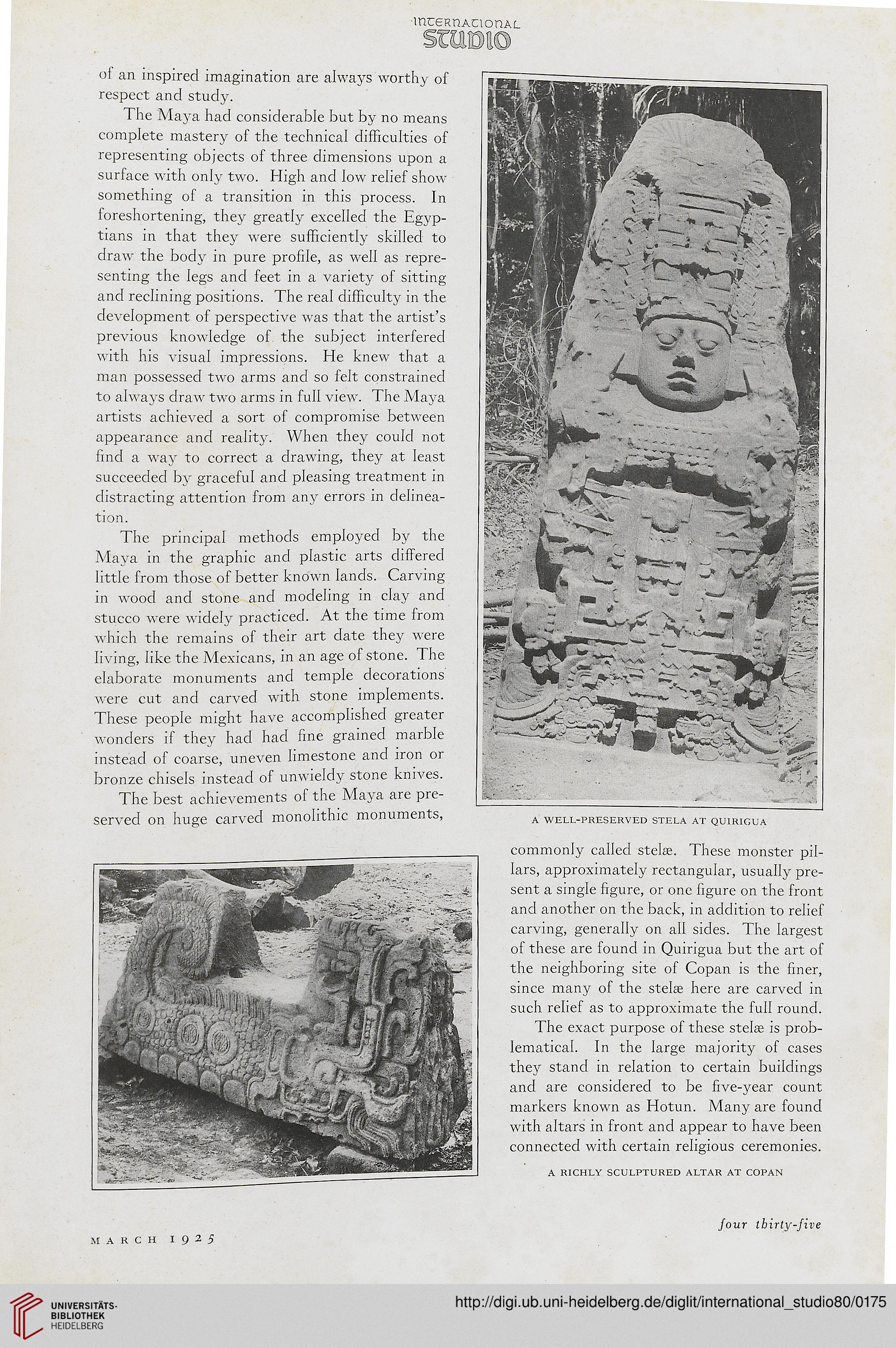lnceRnAcionAL
of an inspired imagination are always worthy of
respect and study.
The Maya had considerable but by no means
complete mastery of the technical difficulties of
representing objects of three dimensions upon a
surface with only two. High and low relief show
something of a transition in this process. In
foreshortening, they greatly excelled the Egyp-
tians in that they were sufficiently skilled to
draw the body in pure profile, as well as repre-
senting the legs and feet in a variety of sitting
and reclining positions. The real difficulty in the
development of perspective was that the artist's
previous knowledge of the subject interfered
with his visual impressions. He knew that a
man possessed two arms and so felt constrained
to always draw two arms in full view. The Maya
artists achieved a sort of compromise between
appearance and reality. When they could not
find a way to correct a drawing, they at least
succeeded by graceful and pleasing treatment in
distracting attention from any errors in delinea-
tion.
The principal methods employed by the
Maya in the graphic and plastic arts differed
little from those of better known lands. Carving
in wood and stone and modeling in clay and
stucco were widely practiced. At the time from
which the remains of their art date they were
living, like the Mexicans, in an age of stone. The
elaborate monuments and temple decorations
were cut and carved with stone implements.
These people might have accomplished greater
wonders if they had had fine grained marble
instead of coarse, uneven limestone and iron or
bronze chisels instead of unwieldy stone knives.
The best achievements of the Maya are pre-
served on huge carved monolithic monuments, A WELL.PRESERVED SXELA AT QUIRICUA
commonly called stelae. These monster pil-
lars, approximately rectangular, usually pre-
sent a single figure, or one figure on the front
and another on the back, in addition to relief
carving, generally on all sides. The largest
of these are found in Quirigua but the art of
the neighboring site of Copan is the finer,
since many of the stelse here are carved in
such relief as to approximate the full round.
The exact purpose of these stela? is prob-
lematical. In the large majority of cases
they stand in relation to certain buildings
and are considered to be five-year count
markers known as Hotun. Many are found
with altars in front and appear to have been
connected with certain religious ceremonies.
A RICHLY SCULPTURED ALTAR AT COPAN
MARCH I925
Jour thirty-Jive
of an inspired imagination are always worthy of
respect and study.
The Maya had considerable but by no means
complete mastery of the technical difficulties of
representing objects of three dimensions upon a
surface with only two. High and low relief show
something of a transition in this process. In
foreshortening, they greatly excelled the Egyp-
tians in that they were sufficiently skilled to
draw the body in pure profile, as well as repre-
senting the legs and feet in a variety of sitting
and reclining positions. The real difficulty in the
development of perspective was that the artist's
previous knowledge of the subject interfered
with his visual impressions. He knew that a
man possessed two arms and so felt constrained
to always draw two arms in full view. The Maya
artists achieved a sort of compromise between
appearance and reality. When they could not
find a way to correct a drawing, they at least
succeeded by graceful and pleasing treatment in
distracting attention from any errors in delinea-
tion.
The principal methods employed by the
Maya in the graphic and plastic arts differed
little from those of better known lands. Carving
in wood and stone and modeling in clay and
stucco were widely practiced. At the time from
which the remains of their art date they were
living, like the Mexicans, in an age of stone. The
elaborate monuments and temple decorations
were cut and carved with stone implements.
These people might have accomplished greater
wonders if they had had fine grained marble
instead of coarse, uneven limestone and iron or
bronze chisels instead of unwieldy stone knives.
The best achievements of the Maya are pre-
served on huge carved monolithic monuments, A WELL.PRESERVED SXELA AT QUIRICUA
commonly called stelae. These monster pil-
lars, approximately rectangular, usually pre-
sent a single figure, or one figure on the front
and another on the back, in addition to relief
carving, generally on all sides. The largest
of these are found in Quirigua but the art of
the neighboring site of Copan is the finer,
since many of the stelse here are carved in
such relief as to approximate the full round.
The exact purpose of these stela? is prob-
lematical. In the large majority of cases
they stand in relation to certain buildings
and are considered to be five-year count
markers known as Hotun. Many are found
with altars in front and appear to have been
connected with certain religious ceremonies.
A RICHLY SCULPTURED ALTAR AT COPAN
MARCH I925
Jour thirty-Jive




